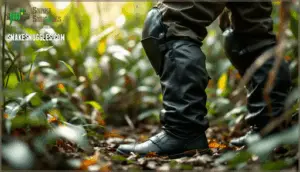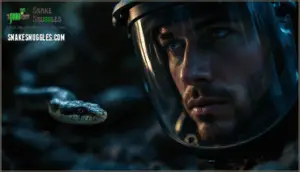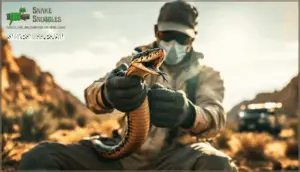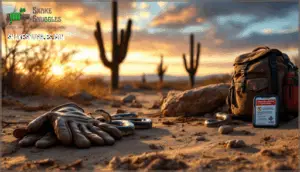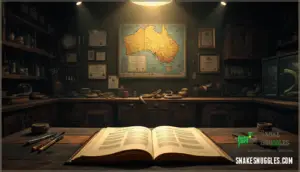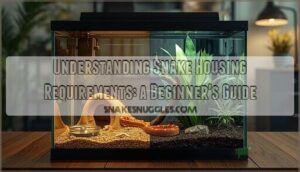This site is supported by our readers. We may earn a commission, at no cost to you, if you purchase through links.
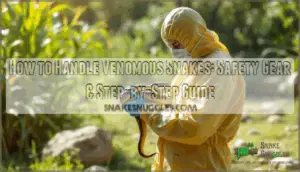
It’s a discipline sharpened through layers of protective gear, practiced movements, and an unwavering respect for the animal’s power. When the stakes are measured in milligrams of venom, there’s no room for improvisation—only the confidence that comes from expert preparation and a clear plan with every move you make.
Table Of Contents
- Key Takeaways
- Essential Safety Gear for Venomous Snake Handling
- Step-by-Step Guide to Handling Venomous Snakes
- Preventing and Responding to Snake Bites
- Legal and Ethical Considerations for Handlers
- Training and Education for Safe Snake Handling
- Frequently Asked Questions (FAQs)
- How to handle venomous snakes safely?
- How to handle a non-venomous snake safely?
- Is there a venomous snake safety training?
- What equipment do you need to handle venomous snakes?
- How do you handle a venomous snake?
- Can you touch a venomous snake?
- What are 3 things you should do if you are bitten by a venomous snake?
- Can you survive a venomous snake bite without treatment?
- How do snakes differ by habitat?
- What feeds do venomous snakes prefer?
- Conclusion
Key Takeaways
- Proper protective gear—puncture-resistant gloves, face shields, specialized clothing, and handling tools like snake hooks and tongs—forms the foundation of safe venomous snake management and directly prevents envenomation injuries.
- Mastering defensive posture recognition, approach techniques, hand positioning, and body control allows you to manage venomous snakes predictably without triggering strikes or causing harm to the animal.
- Immediate response protocols for snakebite—immobilizing the affected limb, removing constrictive items, and calling emergency services for antivenom administration—are critical to survival and must be executed before symptoms worsen.
- Certified training programs combining classroom instruction with supervised hands-on practice under expert guidance are essential for developing the technical precision and ecological knowledge required to handle venomous snakes safely.
Essential Safety Gear for Venomous Snake Handling
Before you pick up any venomous snake, you need the right gear to protect yourself. The equipment you choose can mean the difference between managing safely and a serious medical emergency.
Here’s what you’ll need to work with venomous species safely.
Sturdy Snake Handling Gloves
You wouldn’t ask a surgeon to operate without gloves, and the same principle holds true when you’re working with venomous snakes—your hands are your most vulnerable asset, and protecting them isn’t optional.
When selecting gloves for venomous snake manipulation and safety, prioritize these features:
- Glove materials resistant to fang penetration (leather, Kevlar, or specialized puncture-resistant synthetics)
- Hand protection extending beyond the wrist for complete coverage
- Snake grip texture that maintains secure manipulation without excessive pressure
- Finger dexterity allowing precise tool manipulation and controlled movements
- Wrist support preventing fatigue during extended manipulation sessions
Proper hand protection forms the foundation of snake safety protocols when manipulating venomous snakes safely.
Protective Clothing and Gaiters
While gloves shield your hands from fangs, your legs and torso remain exposed targets—snakes don’t always strike where you expect, and a thorough approach to protective clothing can mean the difference between a close call and a hospital visit.
Snake proof boots and gaiters constructed from puncture-resistant materials provide leg guard protection against defensive strikes.
Armored clothing, including protective suits designed for venomous snake manipulation and safety, should be worn during all manipulation activities. Proper snake safety protocols require full-body coverage when working with medically significant species.
Face Shields and Eye Protection
Spitting cobras can project venom up to eight feet with striking accuracy, targeting the eyes and mucous membranes—a defensive behavior that makes face shields and eye protection essential equipment for anyone working with species capable of venom projection.
Full-face visors constructed from polycarbonate face shield materials offer excellent coverage during venomous snake management and safety operations. Safety goggles with anti-fog coatings prevent visual obstruction, guaranteeing you maintain clear sightlines throughout managing venomous snakes safely.
Protective visors and eye protection gear are integral components of all-encompassing snakebite management protocols during venomous snake training.
Snake Hooks, Tongs, and Other Tools
Beyond the armor you wear, the tools you choose become extensions of your hands. When those hands must keep three feet of distance from fangs that can strike in milliseconds, selecting the right equipment isn’t just practical, it’s your primary defense.
The right tools keep your hands three feet from fangs that strike in milliseconds—selecting them isn’t practical, it’s your primary defense
Snake hooks ranging from 24 to 60 inches allow controlled lifting and maneuvering during venomous snake management and safety operations, while tongs with padded jaws provide secure venomous restraint without causing tissue damage.
Regular tool maintenance guarantees reliability when precision matters most.
Step-by-Step Guide to Handling Venomous Snakes
Managing venomous snakes isn’t something you can wing—it requires a precise sequence of movements and a clear understanding of what you’re doing at each stage. From the moment you approach to the second you release the animal, every action matters.
Here’s how to execute each step with the control and confidence that keeps both you and the snake safe.
Approaching The Snake Safely
Begin from your rear flank—approaching swiftly but smoothly minimizes the chance of triggering a defensive strike. Maintain a safe distance of at least one body length while using proper snake management tools, never your bare hands.
Calm interaction methods require you to read the snake’s posture continuously: a coiled rattlesnake signals readiness to defend, while an extended body suggests potential escape behavior.
Venomous species identification must be absolute before any management of venomous snakes is safely attempted.
Recognizing Defensive Postures
When a venomous snake feels cornered, its body language shifts into unmistakable warning signals that you can’t afford to misread. Threat displays include tightly coiled posturing, elevated head positioning, and sustained direct eye contact—aggression cues that demand immediate retreat.
Rattlesnakes produce acoustic warnings, while cobras flatten their necks into characteristic hoods. Recognizing these venomous signals during snake encounters prevents escalation from defensive posturing into strike behavior.
Proper Hand and Tool Positioning
Precision in positioning your hands and tools isn’t just technique—it’s the margin between controlled management and a life-threatening mistake. Glove selection impacts dexterity during venomous snake manipulation, while tool manipulation requires maintaining visual contact with the snake’s head throughout the procedure.
Essential positioning principles for managing venomous snakes safely:
- Hand placement must always remain behind the snake’s striking range during initial approach
- Precision grip techniques involve controlling anterior body segments without triggering defensive strikes
- Snake restraint requires coordinating hook and tong movements to distribute pressure evenly
- Proper tool manipulation maintains 18-24 inches minimum distance between your hands and the snake’s head
- Venomous snake training emphasizes understanding snake behavior and manipulation mechanics before attempting physical contact
Maintaining Control and Stability
Once you’ve secured proper positioning, the real challenge begins—because even a perfectly controlled snake can shift from docile compliance to explosive movement in a fraction of a second. Stability techniques demand you maintain constant equilibrium while monitoring snake behavior and management cues.
Control methods rely on distributing your grip pressure across multiple body segments—never concentrating force at one point.
Effective management protocols during venomous snake training emphasize reading subtle muscular tension that precedes strikes, ensuring managing venomous snakes safely becomes instinctive rather than reactive.
Preventing and Responding to Snake Bites
Even with proper technique and equipment, venomous snake management carries inherent risks that demand your full attention to prevention and preparedness. Understanding how to avoid bites in the first place—and knowing exactly what to do if one occurs—can mean the difference between a manageable incident and a life-threatening emergency.
The following sections outline critical strategies for bite prevention, immediate first aid protocols, symptom recognition, and when emergency medical intervention becomes non-negotiable.
Bite Prevention Strategies
Preventing a venomous snakebite isn’t just about quick reflexes—it’s about cultivating awareness, respecting boundaries, and making deliberate choices before you ever get within striking range. To minimize bite risk during venomous snake management, you should:
- Study venomous species identification and snake behavior patterns before field encounters.
- Maintain appropriate distance—snakes can strike up to two-thirds their body length.
- Utilize proper tools and avoid hand contact unless formally trained in venomous snake management and safety.
- Implement habitat modification around work sites to reduce unexpected encounters.
- Enroll in certified venomous snake training programs emphasizing snakebite management and prevention measures.
Snakebite First Aid and Emergency Response
Even with perfect prevention habits, you need a clear-headed emergency plan—because the seconds after a venomous bite unfold faster than most people realize, and what you do in those critical moments can mean the difference between a manageable medical event and a life-threatening crisis.
Immediately after envenomation, immobilize the affected limb, remove constricting items, and call emergency services to enable antivenom administration.
Proper first aid for snake bites requires you to avoid wound cleaning, tourniquet application, or incision attempts, as these outdated emergency protocols can worsen tissue damage and complicate medical response.
Recognizing Snake Bite Symptoms
Your ability to recognize the clinical signs of envenomation—from localized swelling and discoloration to systemic neurological changes—directly determines how quickly you’ll mobilize emergency resources and communicate critical information to medical personnel. Watch for these envenoming signs at the bite wound:
- Fang punctures with progressive swelling extending beyond the immediate strike site
- Bruising and tissue discoloration indicating venom effects on local vasculature
- Numbness or tingling radiating from the affected extremity
- Nausea, weakness, or difficulty breathing signaling systemic envenomation
- Altered mental status or vision changes requiring immediate medical response
When to Seek Medical Assistance
Every venomous snakebite—whether you’re confident you identified the species or not—demands immediate transport to the nearest emergency department equipped with antivenom supplies. Don’t wait for symptom recognition to worsen; venom effects progress rapidly, and emergency response protocols prioritize early antivenom administration.
Medical protocols for snake bite treatment options depend on swift first aid and professional assessment—delays compromise your outcome and heighten the dangers of snake bites, even though medical uses of venom extraction techniques exist solely in controlled laboratory settings.
Legal and Ethical Considerations for Handlers
Managing venomous snakes isn’t just about technique—it’s also about knowing the law and doing right by the animals.
Before you pick up a hook or apply for training, you’ll need to understand the regulations that govern venomous snake possession, the certifications required in your area, and the ethical responsibilities that come with working.
State and Local Regulations
Before you manage any venomous snake, you’ll need to understand the patchwork of jurisdictional laws governing possession and use. Regulatory compliance isn’t optional—states like Maryland prohibit entire families of venomous species outright, with legal penalties reaching $10,000 for entities, while South Carolina demands dual containment systems and posted bite protocols.
Enforcement actions can result in immediate seizure, and permit requirements vary dramatically by location. Risk assessment starts with knowing your local statutes, because even professional operators face criminal charges if they violate animal management and safety protocols.
It’s vital to research reptile ownership laws to verify compliance with state regulations.
Permit and Certification Requirements
Permit Applications demand more than curiosity—you’ll need documented permit requirements.
Finding Accredited Training and Mentors
Locating accredited training demands careful vetting—look for programs like the Level 1 Venomous Manipulation Certification Course offered through the Venomous Snake Training Program, where Instructor Certification guarantees Mentorship Programs meet rigorous Training Standards.
Organizations such as the Amphibian Foundation and African Snakebite Institute provide Accredited Courses with verified Mentor Qualifications, essential for mastering Venomous Snake Manipulation and Safety alongside Wildlife Biology and Ecology principles.
Promoting Responsible Snake Ownership
Responsible ownership transforms your commitment to venomous snakes into a safeguard for both human safety and species conservation—it’s where personal accountability meets the broader ethical landscape of wildlife stewardship. You’ll need to:
- Secure proper Pet Permits and understand Reptile Laws governing Venomous Snake Species in your jurisdiction
- Maintain appropriate Snake Habitat conditions that support Conservation Efforts and Venom Research protocols
- Participate in Snake Conservation and Education initiatives while practicing Managing Venomous Snakes Safely through certified Venomous Snake Management and Safety training
Ethical Snake Management extends beyond technique—it demands ongoing education and community responsibility.
Training and Education for Safe Snake Handling
Managing venomous snakes isn’t something you can learn from a book alone—you need structured training that combines classroom knowledge with real-world practice. Formal certification programs teach you the technical skills, safety protocols, and ecological understanding necessary to work confidently with these animals.
Below, we’ll explore the key components of effective snake management education.
Overview of Certified Training Programs
Certified venomous snake management courses usually span two intensive days, delivering 14–18 hours of structured instruction split between classroom theory and hands-on practice. The Level 1 Venomous Management Certification Course and similar Venomous Snake Training Programs cover course curriculum essentials: species identification, venom toxinology, emergency field care, and safe relocation techniques.
Instructor qualifications demand years of professional experience, while program accreditation guarantees compliance with national educational standards. Student assessment involves both written exams and practical competency tests, with classes limited to 15–18 participants.
Training methods emphasize live snake management under expert supervision, equipping you with the precision required for venomous snake management and safety—whether you’re training venom extractors or managing field encounters professionally.
Hands-on Experience and Instructor Guidance
Mastering venomous snake management isn’t built on theory alone—it’s forged through repeated, supervised contact with live specimens under conditions that simulate real-world field scenarios. Instructor techniques emphasize individual attention, correcting hand positioning and grip pressure as you work with non-venomous species before advancing to venomous snake manipulation and safety protocols.
Expert guidance during hands-on training ensures you’ll recognize defensive postures, sharpen tool manipulation, and internalize safety protocols that protect both operator and snake—skills the Venomous Snake Training Program reinforces through progressive difficulty levels customized to manipulating venomous snakes safely.
Understanding Snake Ecology and Behavior
You can’t read a rattlesnake’s intentions if you don’t know what drives its behavior—and that’s where understanding life history, seasonal activity patterns, and ecological role transforms you from a cautious beginner into a caretaker who anticipates movement before the snake makes it.
Mastery of snake ecology and reptile behavior during wildlife encounters requires knowledge of:
- Snake habitat preferences and microclimate requirements
- Venom evolution as a feeding adaptation, not an offensive weapon
- Snake migration patterns tied to breeding and thermoregulation
- Ecological balance maintained through rodent population control
Understanding venomous snakes within their ecological context prevents misinterpretation during snake encounters.
The Role of Conservation in Handling Practices
When wildlife preservation meets venomous snake management and safety, conservation ethics reshape every interaction. Habitat protection and species conservation depend on trained professionals who prioritize reptile management and toxinology over exploitation.
Snake research, herpetology, and conservation efforts demonstrate that snake conservation requires understanding each specimen as a critical component of ecological balance. This transforms routine relocations into meaningful contributions toward wildlife conservation goals.
Frequently Asked Questions (FAQs)
How to handle venomous snakes safely?
Working with venomous reptiles demands specialized knowledge in snake behavior, venom research, and proven management techniques. Conservation efforts rely on trained professionals who understand venomous snake management and safety protocols, while proper venomous reptile management protects both caretakers and snake habitat integrity.
How to handle a non-venomous snake safely?
Ironically, managing non-venomous snakes demands the same respect and precision as working with their venomous counterparts. Understanding snake behavior through herpetology education guarantees proper animal management techniques.
Use snake hooks for reptile management, approach from behind, support the body evenly, and practice safety precautions.
Is there a venomous snake safety training?
Several accredited programs exist, including the Level 1 Management Certification Course and the Rattlesnake Safety Awareness Training Workshop.
These Venomous Snake Training programs cover Snake Safety Protocols, Emergency Response Plans, Venom Toxinology, and Snake Management Techniques essential for working safely with dangerous species.
What equipment do you need to handle venomous snakes?
Managing venomous snakes safely demands an arsenal of specialized equipment that can mean the difference between life and death. Essential tools include snake hooks for distance manipulation, snake tongs for secure grip, protective suits and gloves for bite prevention, venom bags for extraction procedures, and safety nets for containment—all critical components of proper reptile management protocols.
How do you handle a venomous snake?
Professional snake experts approach venomous snakes with deliberate movements from behind, using specialized tools like snake hooks to maintain a safe distance.
Proper technique involves supporting the snake’s body weight evenly, never restraining near the head unless you’re formally trained in venom extraction protocols, and maintaining awareness of defensive postures throughout manipulation.
Can you touch a venomous snake?
Yes, but only with specialized training and proper equipment. Touching a venomous snake without preparation exposes you to severe venom effects and management risks.
Snake behavior remains unpredictable; defensive strikes occur instantly. Trained experts use snake hooks, tongs, and protective gear to maintain a safe distance while managing venomous snakes safely, minimizing envenomation risk.
What are 3 things you should do if you are bitten by a venomous snake?
When bitten by a venomous snake, immediately seek emergency medical treatment for antivenom administration. Remove constrictive items and immobilize the affected limb to slow venom absorption.
Call emergency services and follow their snakebite protocol guidance while remaining calm during transport.
Can you survive a venomous snake bite without treatment?
Survival without treatment depends on venom potency and bite severity. Some snakebite outcomes prove fatal within hours; others cause manageable Venom Effects.
Mortality Factors include species, venom amount, and bite location.
Treatment Options like antivenom dramatically improve Survival Rates, making immediate first aid and medical attention essential for safety.
How do snakes differ by habitat?
Snakes adapt distinctly to their environments. Desert species develop heat-resistant scales and nocturnal behavior. Forest dwellers climb and hunt in canopy cover. Grassland snakes remain ground-bound for rodent hunting. Mountain habitats demand cold tolerance. Wetland ecology fosters aquatic hunters.
Understanding snake ecology and venomous species distribution informs safe wildlife encounters and snake behavior prediction.
What feeds do venomous snakes prefer?
Most venomous species target small mammals, lizards, and occasionally birds based on their size and habitat. Prey selection reflects each species’ venom composition—hemotoxic venoms excel at breaking down tissues in larger prey, while neurotoxic venoms immobilize smaller, quicker targets.
Your understanding of venomous diets informs safer management protocols and relocation strategies.
Conclusion
Managing a venomous snake demands nothing short of absolute precision—one careless moment can rewrite your entire story.
When you master managing a venomous snake through rigorous preparation, protective equipment, and unwavering vigilance, you don’t just survive the encounter; you prove that knowledge transforms danger into manageable risk.
Your respect for the animal’s lethal potential becomes your greatest asset, ensuring every interaction protects both caretaker and creature alike.


